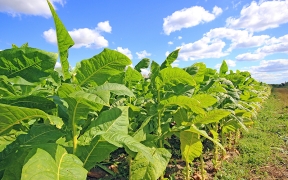Archived article
Please note that tax, investment, pension and ISA rules can change and the information and any views contained in this article may now be inaccurate.

The shares may not be doing much in response to Imperial Brands’ full-year results, but the figures contain a lot that is good news if you are an income investor (less so if you are an ethical investor). Higher prices are offsetting the relentless decline in cigarette volumes, cash flow is strong and the dividend is up.
The fat dividend yield and lowly valuation – the forward dividend yield of 8.5% is higher than the forward price/earnings ratio of around seven times – suggest that investors remain concerned about the long-term future of smoking, thanks to how regulatory pressure and health campaigns continue to weigh on volumes, but Imperial Brands remains highly profitable and cash generative thanks to efficiency drives and pricing power.
That pricing power comes from the FTSE 100 firm’s array of key brands, which includes JPS, Davidoff and Gauloises, despite regulatory intervention on issues such as packaging and advertising.
Pricing power is always valuable, but it is all the more so when inflation is running strongly and firms face margin pressure from rising input costs. Pricing power protects lofty profit margins, lofty profit margins support cash flow and cash flow funds dividends.

Source: Company accounts, Marketscreener, Vuma, consensus analysts' estimates
The dividend cut of 2020 is now fading from memory, as Imperial increases its dividend for the third time in a row and confirms plans, first flagged alongside October’s trading update, for a new £1.1 billion buyback – an increase on the £1 billion programme conducted in the fiscal year to September 2023.
Add the two together and, based on analysts’ consensus forecasts of a further small increase in the dividend for September 2023, Imperial is set to return the equivalent of nearly 15% of its market cap to shareholders in cash.

Source: Company accounts, Marketscreener, Vuma, consensus analysts' estimates
Again, this is possible because of strong cash flow, which comfortably covers the dividend. It even – just – covered the dividend in 2019 before the swingeing cut, but chief executive Stefan Bomhard wisely took the view that long-term investment in the business was a better option than clinging to the millstone of an extremely high yield, for which the firm was getting no credit from investors anyway judging by how the share price was sliding back then.
| £ million | 2019 | 2020 | 2021 | 2022 | 2023 |
|---|---|---|---|---|---|
| Revenues | 7,713 | 7,985 | 7,589 | 7,793 | 8,012 |
| Operating profit | 2,197 | 2,731 | 3,146 | 2,683 | 3,402 |
| Depreciation & amortisation | 1,316 | 910 | 815 | 660 | 632 |
| Net working capital | 50 | 1,042 | (664) | 40 | (347) |
| Capital expenditure | (409) | (302) | (200) | (230) | (325) |
| Operating Cash Flow | 3,154 | 4,381 | 3,097 | 3,153 | 3,362 |
| Tax | (522) | (568) | (820) | (681) | (590) |
| Interest | (473) | (420) | (400) | (358) | (407) |
| Pension contribution | (72) | (88) | (63) | (56) | (29) |
| Leases paid | 0 | (72) | (69) | (68) | (92) |
| Free Cash Flow | 2,087 | 3,233 | 1,745 | 1,990 | 2,244 |
| Dividend | 1,844 | 1,753 | 1,305 | 1,320 | 1,312 |
| Free Cash Flow Cover | 1.13 x | 1.84 x | 1.34 x | 1.51 x | 1.7 |
Source: Company accounts
The long-term reduction in net debt came to a halt in the year to September 2023, thanks to increased inventory, higher capex and – above all – that £1 billion buyback. Had it not been for that, debt would have gone down once more, so management clearly feels it has the correct funding structure, even if the group’s financing costs rose thanks to higher interest rates in the past year.

Source: Company accounts
As it enters the fourth year of chief executive Mr Bomhard’s five-year turnaround plan, Imperial Brands is nevertheless having to work hard. The group’s medium-term plan is to grow sales and operating profit at a mid-single digit percentage rate on a constant currency basis. In fiscal 2024 Mr Bomhard expects low single-digit percentage sales growth with a mid-single digit percentage profit increase, although the earnings advance is expected to be second half weighted.
That sort of forecast tends to make investors nervous, as it suggests more than a few things need to drop right toward the back end of the year for forecasts to be met, and this may explain why the shares trade on such a lowly valuation. Investors are demanding the high yield (with the buyback cash on top to compensate themselves for the perceived risks involved).
The earnings multiple is a discount to the FTSE 100 and the yield a premium. That at least partly reflects the modest growth trend in profits, regulatory threats – including in the UK – and the need to invest in next generation products (NGPs) such as blu, Pulze and iD. Overall NGP revenues rose by a quarter in 2023, although NGP sales in the USA fell by a fifth amid regulatory uncertainty caused by a Food & Drug Administration push against the marketing of my-blu pod-based vapour products.
These articles are for information purposes only and are not a personal recommendation or advice.
Related content
- Wed, 17/04/2024 - 09:52
- Tue, 30/01/2024 - 15:38
- Thu, 11/01/2024 - 14:26
- Thu, 04/01/2024 - 15:13

